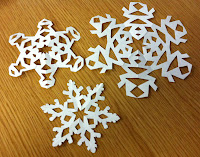The Whitby Literary & Philosophical Society runs Whitby Museum, Library and Archives and has monthly lectures. The Society was established in 1823 and has around 800 members. It is one of the very few remaining Literary & Philosophical Societies that still runs an independent Museum, the older parts of which are often regarded as a 'Museum within a Museum' and have the atmosphere of an Edwardian Museum.
Wednesday, 15 December 2010
Bringing the World to Whitby: Jurassic fantastic puppet show
Bringing the World to Whitby: Jurassic fantastic puppet show: "There are still tickets left for the two performances of this fabulous puppet show on Saturday"
Thursday, 2 December 2010
Tuesday, 23 November 2010
Snowflakes
In the run up to Christmas each year there is a display of Christmas trees in St Mary's Church in Whitby. This year I suggested that the theme for decorating the museum's tree should be snowflakes. This is inspired by the beautiful drawings of snowflakes in the museum collection done by Captain William Scoresby Junior. He was a successful whaling captain and while in the Arctic regions he surveyed the coasts of Greenland and Jan Mayan island and studied the flora and fauna and ice and snowflake formations under different weather conditions. The museum has a substantial collection of his scientific instruments, many of which are on display. He also made many beautiful sketches of ice formations and of birds he observed.
Here is a picture of some of the drawings by Scoresby and some of my 'test' paper snowflakes. On Thursday 25th November at 2pm a small group of us will be attempting to make enough to cover our tree, please join us if you can.
Here is a picture of some of the drawings by Scoresby and some of my 'test' paper snowflakes. On Thursday 25th November at 2pm a small group of us will be attempting to make enough to cover our tree, please join us if you can.
Wednesday, 17 November 2010
A bear?
 One of the objects in the museum collection that really has impact is this colourful totem pole from Nootka Sound. Nootka Sound is on the north west coast of Vancouver, one of the areas visited by Captain James Cook in March 1778, with two vessels, the Resolution and the Discovery. They were in search of the North west passage. This totem is from a much later date and stands at the back of the main room of the museum, close to the back doors. It is a beautiful and colourful object and I have been trying to find out about the significance of the bear (shown here in my photograph) as the other figures all have an explanation listed for them.
One of the objects in the museum collection that really has impact is this colourful totem pole from Nootka Sound. Nootka Sound is on the north west coast of Vancouver, one of the areas visited by Captain James Cook in March 1778, with two vessels, the Resolution and the Discovery. They were in search of the North west passage. This totem is from a much later date and stands at the back of the main room of the museum, close to the back doors. It is a beautiful and colourful object and I have been trying to find out about the significance of the bear (shown here in my photograph) as the other figures all have an explanation listed for them. Monday, 27 September 2010
Carved and painted wooden bird
This has to be one of my favourite objects in the museum collection. It is a carved and painted wooden bird. It's label says that it was brought from New Ireland and was given to the museum by Captain Readman in 1928. It is such a vibrant piece. I would love to know what significance or meaning it had originally?
Monday, 30 August 2010
Adze
This is part of an Adze in the museum collection. I am intrigued by the way in which different materials were used and joined together. Here very finely plaited plant fibres, possibly either coconut or flax, are intricately wound to join the basalt head of the adze to the carved shaft.
It comes from the Pacific region and this example is possibly ceremonial.
Friday, 20 August 2010
Precious Cargo - Stories of the World in Yorkshire
Our project Bringing the world to Whitby is looking at the history and the heritage of selected objects in Whitby Museum and where they are from. Some pieces may have a special meaning to one person as well as having a shared history that can be appreciated by many people. Some of the objects were brought from cultures on the other side of the world at a time when few people had opportunities to travel. Some of those places and cultures are now under threat due to changes in society, technology and the environment.
In this blog we hope to share some ideas about these objects and explore links to other museum collections.
All text and images under copyright. Please contact the Museum for permission to use.
In this blog we hope to share some ideas about these objects and explore links to other museum collections.
All text and images under copyright. Please contact the Museum for permission to use.
Subscribe to:
Posts (Atom)





